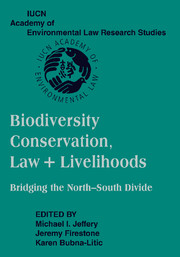 Biodiversity Conservation, Law and Livelihoods: Bridging the North-South Divide
Biodiversity Conservation, Law and Livelihoods: Bridging the North-South Divide Published online by Cambridge University Press: 31 July 2009
INTRODUCTION
The term “biodiversity” was not coined until the 1980s, when it was popularised by the eminent Harvard biologist E. O. Wilson. The most tangible manifestations of biodiversity are the species of plants, animals and micro-organisms that surround us. Yet biodiversity means more than just species diversity. At the micro level, it includes the genetic material that makes up the species, whereas at the macro level, it covers natural communities, ecosystems and landscapes. Biodiversity essentially relates to the full array of life on Earth.
In an apparently continuous movement, biodiversity emerged over the course of the geological eras, wending its way through both biological evolution and periods of mass extinction. Such diversification of the living world is made possible by the genetic adaptation of species to environmental changes, whether natural or human caused. Communities themselves evolve on the basis of fluctuations in their environment, according to complex historical processes that explain the present state of the biosphere. The first living beings appeared in the oceans roughly 3.5 billion years ago in the form of primitive bacteria, which subsequently diversified into the multitude of organisms of every shape and size and are now classified under five kingdoms (animal, plant, fungi, bacteria, and protists), each of which is divided into systematic classifications that emerged following the branching out of the particular species. Humankind has still a long way to go before acquiring a complete knowledge of the species that populate the Earth.
To save this book to your Kindle, first ensure [email protected] is added to your Approved Personal Document E-mail List under your Personal Document Settings on the Manage Your Content and Devices page of your Amazon account. Then enter the ‘name’ part of your Kindle email address below. Find out more about saving to your Kindle.
Note you can select to save to either the @free.kindle.com or @kindle.com variations. ‘@free.kindle.com’ emails are free but can only be saved to your device when it is connected to wi-fi. ‘@kindle.com’ emails can be delivered even when you are not connected to wi-fi, but note that service fees apply.
Find out more about the Kindle Personal Document Service.
To save content items to your account, please confirm that you agree to abide by our usage policies. If this is the first time you use this feature, you will be asked to authorise Cambridge Core to connect with your account. Find out more about saving content to Dropbox.
To save content items to your account, please confirm that you agree to abide by our usage policies. If this is the first time you use this feature, you will be asked to authorise Cambridge Core to connect with your account. Find out more about saving content to Google Drive.